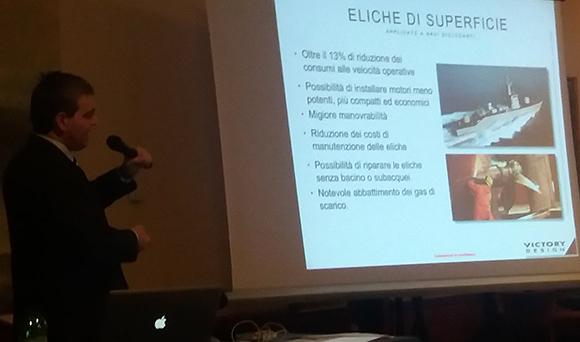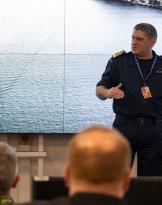The convention dedicated to the "Surface Propeller Technology applied to displacement hulls" was staged at the "Caio Duilio" Navy Officers' Club. Organized by the Italian Institute of Navigation (IIN), represented the first of many conferences that will be organized in the coming months.
Dr. Palmira Petrocelli, President of the IIN, intervened to open the debate and remarked how much this technology is "an absolute novelty for everyone, very important given that it could be the future of navigation". His brief speech was followed by that of Eng. Leonardo Quattrocchi, with a speech focused on the importance of technology in the development of navigation and, in a broad sense, for everything that concerns the everyday.
The final question of his speech, or if it is possible to apply the technology of the Surface Propellers to large ships, was posed to the main intervention, namely that of Eng. Brunello Acampora, depositary of the patent on their application to displacement hulls together with the late Ing. Renato "Sonny" Levi. His response was that "at the moment this technology has been tested, perfectly, only on small ships, but the future will allow their application even on very large hulls".
The study of this new technology was initially entrusted to CFD (Computational Fluid Dynamics), a method that allows the analysis of fluid movement by computer.
"The CFD allowed us to study the applications of Surface Propellers, without having to do the physical test", This is Acampora's comment regarding this fundamental software. From these tests, supported by tests carried out at both the University of Genoa and the University "Federico II" of Naples, surprising results emerged, even for those who firmly believed in this project. First of all the maximum possible speed, greater than the 10% compared to the traditional propellers, then the fuel consumption which with -13,8% would limit the costs of managing the ships. These, however, are not the only positive data that allow Acampora to be sure of their future use. Remaining on the purely motor issue, the Surface propellers they would allow the installation of a smaller engine, which would have lower emissions into the air, important in a world increasingly sensitive to ecology. The smaller motor would not be a disadvantage, because this would compensate for the larger diameter of the propeller, which would cause the efficiency of the motor to be greater than traditional propellers, because "increasing the diameter of the propeller increases its efficiency".
Another important aspect is the aesthetic-functional one. Acampora stressed that "Surface Propellers do not affect minimally the space available in the aft deck”, Also because the propellers are inserted in a special tunnel, above which it is possible to maintain the bridge. A technology that, in addition to the Navy, could become fundamental also for the large container ships that sail the seas and oceans. Of problems Acampora, momentarily, sees none but the necessity to rethink the hulls of the ships. His confidence in "his" technology is great and, seeing the data and listening to his words, one can only think that the Surface propellers are really the future of navigation.
(photo of the author)












